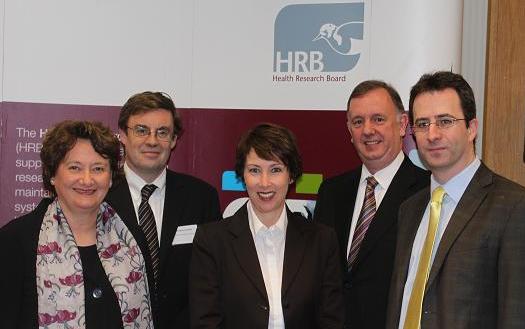Long, Jean
(2011)
From research to policy: the Sax Institute seminar.
Drugnet Ireland,
Issue 37, Spring 2011,
pp. 4-5.

Professor Sally Redman, Mr Michael Scanlan, Ms Deborah Frew, Mr Enda Connolly, and Mr Jim Breslin
In February 2011 the Department of Health and Children (DoHC) and the Health Research Board (HRB) organised a workshop and seminar examining the Australian experience of evidence-informed policy and knowledge brokering. The events were facilitated and presented by Professor Sally Redman and Ms Deborah Frew from the Sax institute in New South Wales, Australia (www.saxinstitute.org.au).
Mr Jim Breslin, DOHC, and Mr Enda Connolly, HRB, opened the seminar. Mr Breslin said that the seminar would provide strategies that would assist policy makers to direct and use research to inform policy and would enable researchers to complete research that was relevant to policy making. Mr Connolly reported that the HRB’s Strategic Business Plan 2010–14 will increase the Board’s investment in population health and health services research and facilitate the Department in locating and using this and other appropriate research.
Dr Redman said that the Sax Institute wanted to create a two-way bridge between policy (makers) and research(ers). Her research in this area in 2003 found that policy makers wanted research that was timely, relevant, of high quality and easy to understand. In addition, policy makers wanted research that found specific, acceptable and appropriate evidence-based solutions to problems. Dr Redman identified three ways in which policy makers and researchers interact: the scientific approach (where researchers do and publish research and policy makers are responsible for locating and using it), the advocacy approach (where researchers do research and lobby for its use in policy) and the partnership approach (where policy makers and researchers decide the research needs together). There is not enough evidence to identify which, if any, approach is best.
The partnership approach appears to enhance exchange of knowledge between policy makers and researchers. Ms Frew reported that the Sax Institute uses Lomas’s definition of knowledge brokering, which identifies the broker as an intermediary between research(er) and policy (maker).1 The knowledge broker can be an institution or a person. The knowledge brokers at the Sax Institution are experienced both as researchers and as policy makers. The interventions that facilitate good knowledge brokering are structured process, strict parameters and feedback. A knowledge brokering session is most effective when the policy maker is clear about their needs, and the broker establishes a rapport with the policy maker, listens to their needs and clarifies research questions with them.
Ms Frew described the rationale for the Sax Institute Knowledge Transfer and Communications Programme. In 2003, the Institute found that 39% of policy makers believed that research was not relevant to policy; 87% said that research was not presented in a useful format; and only 5% had ever used research to inform policy. Seventy-two per cent of policy makers wanted brief research summaries. The Institute developed an evidence check process to facilitate a review of existing research and evidence tailored to the specific needs of the policy maker. Since 2003 the Institute has completed 90 evidence reviews on a wide variety of topics. Each review takes approximately eight weeks to complete. The Institute follows up on the use of evidence reviews three months after they are completed to determine satisfaction with the process and how the review is used.
The Department of Health and Children has asked the HRB to complete a number of evidence reviews by September 2011 using the evidence check process.
1. Lomas J (2007) The in-between world of knowledge brokering. British Medical Journal, 334(7585): 129–132.
